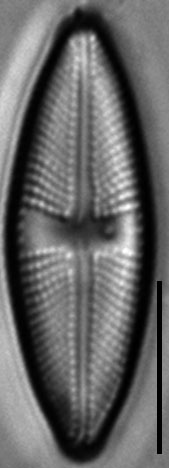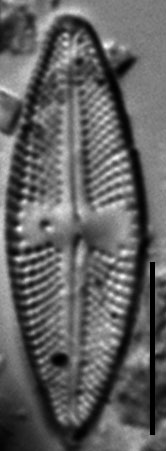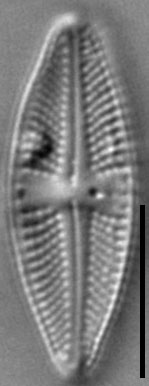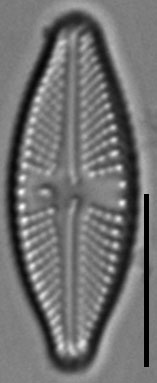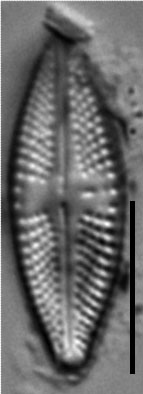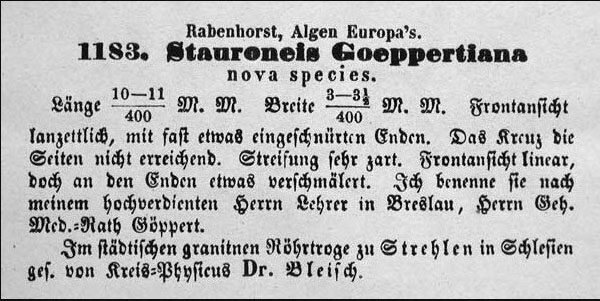Luticola goeppertiana
-
Category
-
Length Range20.1-31.1 µm
-
Width Range6.3-8.9 µm
-
Striae in 10 µm14-20
-
SynonymsNavicula goeppertiana (Bleisch) H.L.Sm.
Navicula mutica f. goeppertiana (Bleisch ex Rabenh.) Cleve
Navicula mutica var. goeppertiana (Bleisch) Grunow
-
Reported AsNavicula mutica (Patrick and Reimer 1966, pg. 454, Pl. 42, Fig. 2)
Navicula mutica (Hustedt, 1930, pg. 274-275, Pl. 453, Fig. a)
-
ContributorJaclyn Rarick - Jun 2017
-
ReviewerIan Bishop - Jun 2017
Identification
Description
Valves are lanceolate, with rounded and slightly protracted apices. In larger cells, the valve margins are less elliptic and the apices are less protracted, and in some specimens, are narrowly rounded. The axial area is narrow, linear, and expands near the central area. The central area is a bowtie shape. The central area is bordered by 2-4 single areolae on each valve margin. The striae are punctate and radiate throughout. A single, isolated, slit-like, transapically elongated stigma is located in the central area halfway between the valve center and the margin. Raphe branches are straight. The proximal raphe ends deflect to the side opposite of the stigma. The distal raphe ends are hooked and deflected toward the same side as the proximal raphe ends, then hooked towards the opposite side onto the valve mantle.
There has been nomenclatural confusion surrounding Luticola goeppertiana. The basionym is Stauroneis goeppertiana (Bleisch ex Rabenhorst) 1861, which was later transferred to Navicula, as Navicula goeppertiana (Bleisch) H.L. Smith 1876. However, as noted by Patrick and Reimer (1966), Stauroneis goeppertiana and Navicula mutica var. goeppertiana were both synonyms of Navicula mutica. The type specimens of L. goeppertiana and L. mutica differ in morphology (Levkov et al. 2013). Luticola mutica is more linear, whereas L. goeppertiana is more lanceolate. Striae on L. goeppertiana are more dense than on L. mutica. Furthermore, the stigma of L. mutica is an elliptic shape, while L. goeppertiana has a transapically elongated stigma.
Until recently (Rarick et al. 2017), L. goeppertiana was invalid because Round et al. (1990) did not provide a full and direct citation of the basionym when transferring N. mutica var. goeppertiana to L. goeppertiana. The valid transfer of Stauroneis goeppertiana to Luticola goeppertiana (Bleisch) D.G.Mann ex J.Rarick, S.Wu, S.S.Lee and Edlund 2017 was made, so the name is now valid as L. goeppertiana (Rarick et al. 2017).
Autecology
Luticola goeppertiana was found growing on a boat dock on the Des Moines River, Polk County, Iowa. It was also found in an epilithic sample on a boat ramp from the Cedar River Reservoir, Bremer County, Iowa. The genus Luticola is typically associated with subaerial, acidic, or heavily polluted habitats (Pavlov et al. 2009) as well as damp mosses, rocks, wet walls and soils. Specifically, L. goeppertiana has indicated a high pollution tolerance and is resistant to organic pollution. Ecological records show that L. goeppertiana are widely distributed in eutrophic and eusaprobic waters. Other studies have been done through north and south Europe and Central and South America (Levkov et al. 2013).
Interestingly similar to the modern collections of this taxon from man-made structures, the original material containing L. goeppertiana was collected by Bleisch from the walls of a granitic pipe holder on the market place of Strzelin in Poland, formerly known by the German name, Strehlen, Province of Silesia/Schlesien, Kingdom of Prussia (Rabenhorst 1861, Pavlov et al. 2009).
-
Size Range, µm3
-
Attachment
-
Habitat
-
Colony
-
Occurrence
-
BCG
-
Waterbody
-
Distribution
- Learn more about this
Citations & Links
Citations
-
Publication Link: 10.1127/0029-5035/2009/0089-0147
Links
-
Index Nominum Algarum
-
GenBank
-
North American Diatom Ecological DatabaseNADED ID: 130006
Cite This Page
Rarick, J. (2017). Luticola goeppertiana. In Diatoms of North America. Retrieved April 30, 2024, from https://diatoms.org/species/luticola_goeppertiana
Responses
The 15 response plots show an environmental variable (x axis) against the relative abundance (y axis) of Luticola goeppertiana from all the stream reaches where it was present. Note that the relative abundance scale is the same on each plot. Explanation of each environmental variable and units are as follows:
ELEVATION = stream reach elevation (meters)
STRAHLER = distribution plot of the Strahler Stream Order
SLOPE = stream reach gradient (degrees)
W1_HALL = an index that is a measure of streamside (riparian) human activity that ranges from 0 - 10, with a value of 0 indicating of minimal disturbance to a value of 10 indicating severe disturbance.
PHSTVL = pH measured in a sealed syringe sample (pH units)
log_COND = log concentration of specific conductivity (µS/cm)
log_PTL = log concentration of total phosphorus (µg/L)
log_NO3 = log concentration of nitrate (µeq/L)
log_DOC = log concentration of dissolved organic carbon (mg/L)
log_SIO2 = log concentration of silicon (mg/L)
log_NA = log concentration of sodium (µeq/L)
log_HCO3 = log concentration of the bicarbonate ion (µeq/L)
EMBED = percent of the stream substrate that is embedded by sand and fine sediment
log_TURBIDITY = log of turbidity, a measure of cloudiness of water, in nephelometric turbidity units (NTU).
DISTOT = an index of total human disturbance in the watershed that ranges from 1 - 100, with a value of 0 indicating of minimal disturbance to a value of 100 indicating severe disturbance.
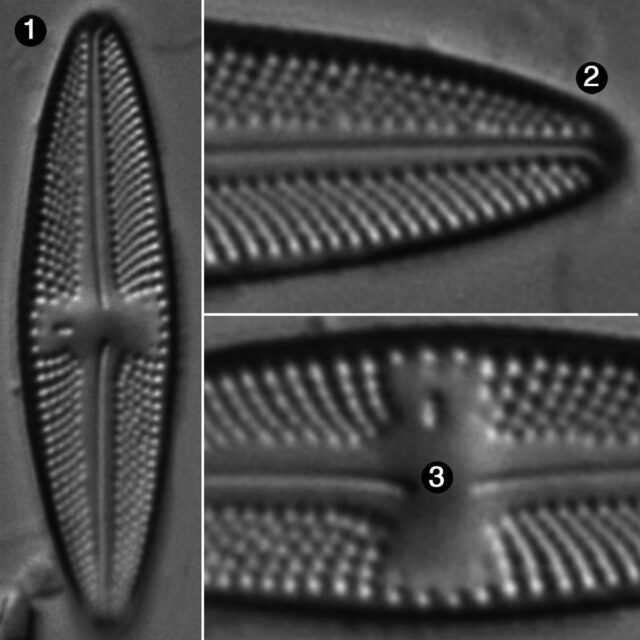
Luticola goeppertiana
- Valves linear-lanceolate to lanceolate
- Apices narrow
- Central area bowtie-shaped
- Striae radiate
Valves are linear-lanceolate with narrow apices. The central area is bowtie-shaped. Striae are curved and radiate.
 Diatoms of North America
Diatoms of North America
